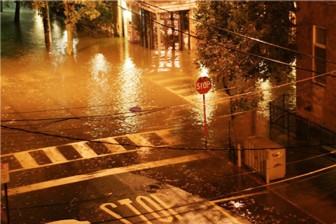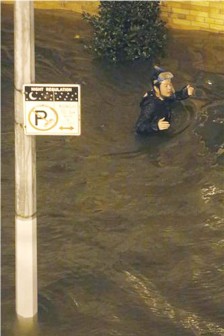NEW YORK/REHOBOTH BEACH, Del (Reuters) – Sandy, one of the biggest storms ever to hit the United States, roared ashore with fierce winds and heavy rain yesterday near the gambling resort of Atlantic City, forcing evacuations, shutting down transportation and interrupting the presidential campaign.
Early reports said there was widespread flooding through New York City, in some cases well inland. Police confirmed at least two people were killed by the storm in the city, and deaths were reported as far away as Toronto as well.
High winds and flooding racked hundreds of miles (km) of Atlantic coastline while heavy snows were forecast farther inland as the center of the storm marched westward.
The storm’s wind field stretched from the Canadian border to South Carolina, and from West Virginia to an Atlantic Ocean point about halfway between the United States and Bermuda, easily one of the largest ever seen.

More than 3 million customers already were without power by early evening and more than one million people were subject to evacuation orders. Many communities were swamped by flood waters.
The National Hurricane Center said Sandy came ashore as a “post-tropical cyclone,” meaning it still packed hurricane-force winds but lost the characteristics of a tropical storm. It had sustained winds of 80 miles per hour (129 kph), well above the threshold for hurricane intensity.
The storm’s target area includes big population centres such as New York City, Washington, Baltimore and Philadelphia.
Trees were downed across the region, untethered pieces of scaffolding rolled down the ghostly streets of New York City, falling debris closed a major bridge in Boston and floodwater inundated side streets in the resort town of Dewey Beach, Delaware, leaving just the tops of mailboxes in view.
In Fairfield, a Connecticut coastal town and major commuter point into Manhattan, police cruisers blocked the main road leading to the beaches and yellow police tape cordoned off side entrances. Beach pavilions were boarded up with plywood, and gusts of wind rocked parked cars.
“People are definitely not taking this seriously enough,” said police officer Tiffany Barrett. “Our worst fear is something like Katrina and we can’t get to people.”
US stock markets were closed for the first time since the attacks of Sept 11, 2001, and will remain shut today.
The federal government in Washington was closed and schools were shut up and down the East Coast.
One disaster forecasting company predicted economic losses could ultimately reach $20 billion, only half insured.
Governors up and down the East Coast declared states of emergency. Maryland’s Martin O’Malley warned there was no question Sandy would kill people in its path.

Two people died in the New York borough of Queens, a man in a house hit by a falling tree and a woman who stepped into an electrified puddle of water. Toronto police also recorded one death, a woman hit by flying debris.
Sandy made landfall just south of Atlantic City, about 120 miles (193 km) southwest of Manhattan. Casinos in Atlantic City had already shut down.
Television images showed water rising to historic heights in lower Manhattan, raising the possibility of flooding in the city’s subway system. The New York Daily News reported that water was six feet deep outside its offices in lower Manhattan.
New York electric utility Con Edison said it expected “record-size outages,” with 588,000 customers in the city and nearby Westchester County without power. The company is facing both falling trees knocking down power lines from above and flood waters swamping underground systems from below.
A Reuters witness said 19 Con Edison workers were trapped by rising floodwaters in a power station on the east side of Manhattan.
“In the olden days, you would have had lots of fatalities. We’re not through this yet. … It may be as bad of (a) storm as we’ve ever seen, but I would expect the damage to be relatively minor,” New York City Mayor Michael Bloomberg told a news conference last evening.
The damage was not restricted to the island’s southern tip, though, as serious flooding was reported miles north in Greenwich Village and Chelsea.
City officials evacuated neighbours of a 90-storey super luxury apartment building under construction after its crane partially collapsed in high winds, prompting fears the entire rig could crash to the ground.
As runways, roads, bridges and tunnels were progressively shut down by the storm yesterday, it became difficult if not impossible to get from Washington to New York City along what is normally one of the most heavily travelled corridors in the United States.
While Sandy does not have the intensity of Hurricane Katrina, which devastated New Orleans in 2005, it has been gathering strength. It killed 66 people in the Caribbean last week before pounding US coastal areas as it moved north.
An AccuWeather meteorologist said Sandy “is unfolding as the Northeast’s Katrina,” and others said Sandy could be the largest storm to hit the mainland in US history.
The storm interrupted the US presidential campaign with eight days to go before the election, as President Barack Obama and Republi-can challenger Mitt Romney cancelled events.
Both men acted cautiously to avoid coming across as overtly political while millions of people are imperiled.
Off North Carolina, the US Coast Guard rescued 14 of the 16 crew members who abandoned the replica ship HMS Bounty, using helicopters to lift them from life rafts. The Coast Guard later recovered the body of an “unresponsive” 42-year-old woman while continuing to search for the 63-year-old captain of the ship, which sank in 18-foot (5.5 meters) seas.
Besides rain, the storms could cause up to 3 feet (1 meter) of snowfall in the Appalachian Mountains from West Virginia to Kentucky. Some people in that part of the country did not have to go to work because of the storm and used the time to vote.
At the Berkeley County Courthouse in Martinsburg, West Virginia, early voting for the Nov 6 elections was going ahead despite the bad weather, with hundreds of people casting ballots.
“More (people) came out today than what I anticipated but a lot of people are off work,” Bonnie Woodfall, chief deputy for voter registration, said after fielding a flurry of calls about whether the polls should stay open. “It’s neat.”
On the small New York island neighbourhood of City Island, which juts into Long Island Sound east of the Bronx, many residents were ignoring a mandatory evacuation order. The narrow island, known for its seafood joints and maritime-themed antique shops, is home to an isolated, working-class community of New Yorkers who say they’re used to big storms and flooding.





